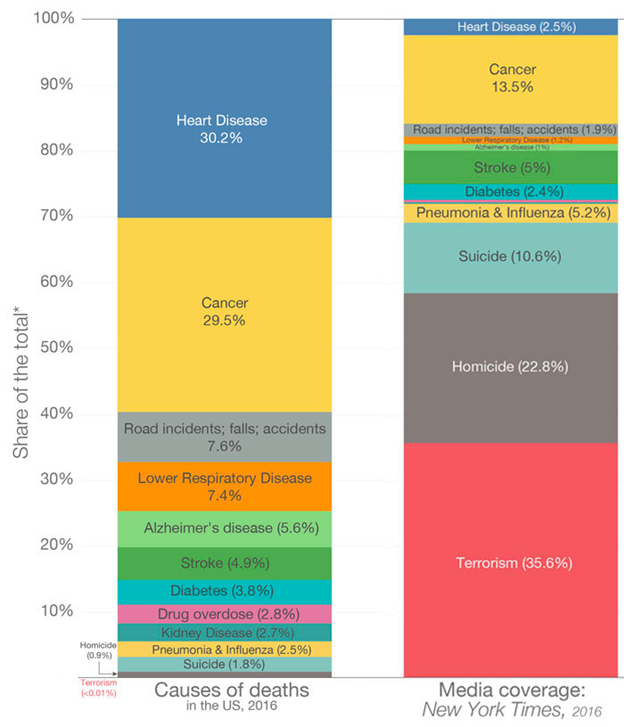The Daily Escape:

View of fall colors and Linn Cove Viaduct, Banner Elk, NC – October 2023 photo by David Peak
Polls continue to show that people think the economy is terrible and that it’s Biden’s fault. Biden supporters chalk it up to the general unreliability of surveys: Asking people questions and then assuming their answers are accurate or honest. But often, they are not because people find it difficult to say, “I don’t know.”
A second issue is the astounding changes in polling data over the past decade: People’s self-reported emotional state in 2022 was worse than the very worst events of the past few decades. But are things as bad as people seem to think? From Barry Ritholtz:
“From an economic standpoint, things are much better than people seem to be willing to admit: The rate of inflation has plummeted by two-thirds from 9% to a little over 3%, but 60% of respondents believe inflation is “continuing to increase.” The economy is not on the right track, even as Americans’ Net Worth Surged by Most in Decades During Pandemic.”
And the political fallout may be worse than you think. Bloomberg’s recent poll reveals some significant danger for Biden:
“Donald Trump is leading President Joe Biden in several key swing states as voters reject the economic message that is central to Biden’s reelection bid….Trump…leads Biden 47% to 43% among voters in Arizona, Georgia, Michigan, Nevada, North Carolina, Pennsylvania and Wisconsin. The results across those seven states had a margin of error of 1 percentage point.”
Thirteen months before the election, Biden lags Trump in head-to-head matchups in five of the seven swing states. These states will be particularly important in delivering the electoral votes that decide who will be the next president. More from Bloomberg:
“A 51% majority of swing-state voters said the national economy was better off during the Trump administration, and similar numbers said they would trust Trump over Biden on the economy going forward, 49% to 35%. Among independent voters, the chasm on trust to handle the economy is even wider, with a 22-point advantage for Trump.”
Seems like a problem. This is despite the fact that, since 2019, households invested more, home values have jumped, and savings levels have risen. Here’s more from Bloomberg’s polling partner Morning Consult’s Caroline Bye:
“Right now, Biden is not getting any credit for work he’s done on the economy….Almost twice as many voters in the swing states are saying that Bidenomics is bad for the economy, as opposed to good for the economy, which is a really startling fact if you’re the Biden campaign.”
Why is it that people’s perception doesn’t match the data? Back to Ritholtz, who thinks the fault may lie with the media:
“…the 2010s seems to be when they shifted their online presence to a much more aggressive stance. Perhaps most significant is in the way coverage became increasingly “click-bait” oriented via headlines filled with emotionally loaded language….Words that conveyed “Disgust” rose 29% and “Sadness” was 54% higher; words that reflected “Anger” were up 104%. The biggest gain was from perhaps the most emotionally loaded word: “Fear” skyrocketed by a huge 150%. And the words expressing “Joy” or “Neutral?” Down 14% and 30% respectively.”
But it isn’t just the media’s headlines that are hurting people’s perceptions; it’s also the choice of what the media covers that can lead us astray. Ritholtz provides us with a fantastic chart about the causes of death in the US from Our World in Data comparing actual causes of death with what was reported in the NYT:

This shows that the way the media covers deaths this is totally inverted: The things least likely to kill you get the most coverage: The bar chart on the right shows Terrorism, Homicide, and Suicide capture about 70% of the column inches. This is despite the odds that you are most likely to die from heart disease (30.2%), cancer (29.5%), or a car accident or fall (7.6%). The very bottom of the list are suicide at 1.8%, homicide at 0.9%, and terrorism at 0.01%.
So do negatively-laden headlines matched with wildly disproportionate coverage combine to send sentiment readings to places that do not match the reality of the economy or more broadly, the real world around us?
We’ve always had sensationalist journalism. The media’s response to social media is to approach news coverage in a similar manner to social media. Apparently the business plan is: If you can’t beat ’em, join ’em. It’s important to remember that we are what we eat, including our media diet. It’s making us unhappy, and increasingly detached from reality.
There are a few economic realities that may help explain where the public is right now:
- Gas prices are both very volatile, and something that annoys an enormous percentage of Americans, because of the need to spend large amounts of money on a weekly basis to fuel their gas guzzling vehicles.
- The housing market is a mess. The median sale price of a house in the USA went from $313,000 in 2019 to $480,000 in 2022. Since then the massive spike in interest rates has reduced median price to $416,000, but coupled with high mortgage rates, this is bad news for people wanting to buy homes in this market.
From a behavioral economics viewpoint, the extent of peoples’ reaction to price inflation may reflect the concept that people are loss averse: that is, they dislike what they perceive as losses more than they like what they perceive as gains.
This means if prices and wages were to increase at the same rate, politicians might assume that people would be indifferent to the nominal changes in prices, since they would be offset by wage increases. But if Americans are loss averse, when prices and wages both go up by a significant amount, (as they have over the past three years), people feel worse, because the “loss” incurred through higher prices feels worse than the “gain” of higher wages.
Time to wake up America! Perception isn’t fact until it is. How Dems fight this will determine the outcome of the 2024 election. To help you wake up, watch and listen to Bruce Springsteen perform “How Can a Poor Man Stand Such Times and Live”, live at the New Orleans Jazz & Heritage Festival in 2006. This is one year after Katrina, which Bruce focuses on at the start of the song:
Sample Lyrics:
Well, the doctor comes ’round here with his face all bright
And he says, “In a little while you’ll be all right”
All he gives is a humbug pill, a dose of dope and a great big bill
Tell me, how can a poor man stand such times and live?

I suggest one part of the problems (I base this on Sarah Longwell’s “Focus Group” podcasts) is the for Dems, the watch media that have no agenda other than to get viewers/readers. Thus MSNBC will have Chris Christie on and they let go unchallenged his characterization of Biden as basically hopeless. But the right wing media, while they will fact check from time to time, they present a picture of Biden and dems as if they are radical and incompetent. for average folks, there is no wonder that most people think govt is hopeless and Biden specifically is a demented incompetent.
So the overall weight is to present a false narrative of an america where most are working, and spending levels are high.
Excellent analysis!! Why aren’t the Dems more vocal Now? Hope you forward this to the NYT as an op-ed piece!
Late to the dance, but WOW!
I am shocked by the magnitude of disconnect. And this is not some loud-mouthed rag we’re talking about, not some social media outlet selling eyes without any professional code to curb their ardor. Wow, indeed!
I like David Kroner’s suggestion. You can do this.
It seems we in the U.S. are arms suppliers to the free world, but now challenged in Syria, (Iran), Ukraine, (Russia), Gaza(Israel),and Taiwan (China). In terms of realpolitik we can no longer be the world’s policeman. It’s time for all our allies to step up to the plate and assist. Unfortunately, looking like Armageddon with sticks and stones to follow.